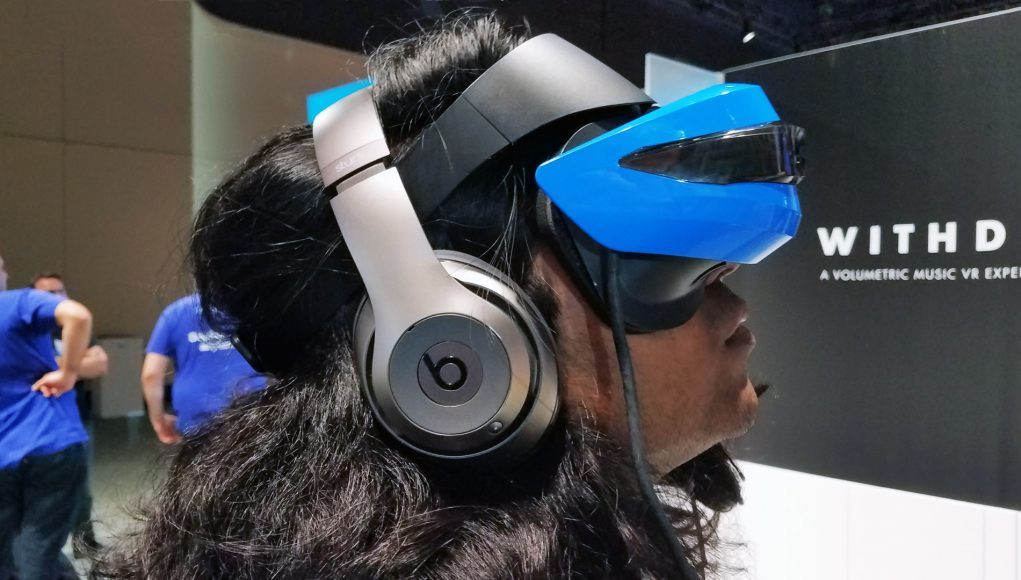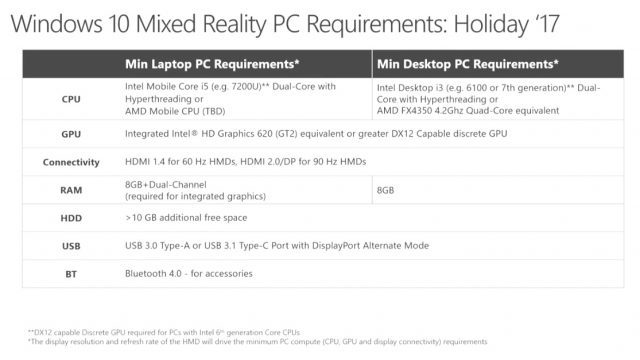Thursday morning at Microsoft’s Build conference, the company announced the opening of pre-orders for two new VR dev kits. Developers in the US and Canada can now pre-order the Acer ($299) and HP ($329) Mixed Reality headsets. Delivery of the headsets is scheduled for August 2017. I was able to get hands on with the dev kit version of the Acer headset at Build this week and organized my thoughts into broad categories below.
Acer VR Headset & Minimum PC specs
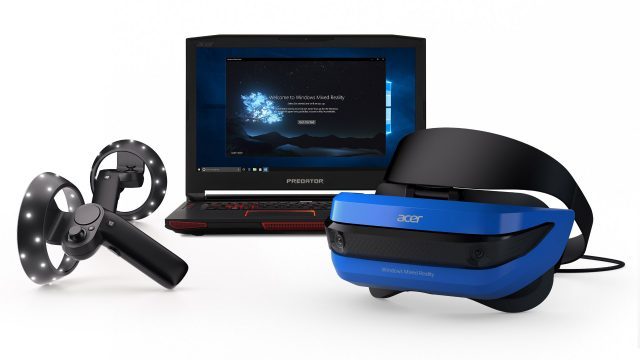 Headset specs
Headset specs
- 2x LCD displays, 1440 x 1440
- 2.89” diagonal display size (x2)
- Front hinged display
- 95 degrees horizontal field of view
- Display refresh rate up to 90 Hz (native)
- Built-in audio out and microphone support through 3.5mm jack
- Single cable with HDMI 2.0 (display) and USB 3.0 (data) for connectivity
- Inside-out tracking
- 4.0 meter cable
- Sensors: Accelerometer, Gyroscope, Magnetometer, Proximity
- Dimensions (L x W x H) 195.8 x 94.8 x 106.59 mm
- Weight: 350 grams
Minimum PC Specs for Developers
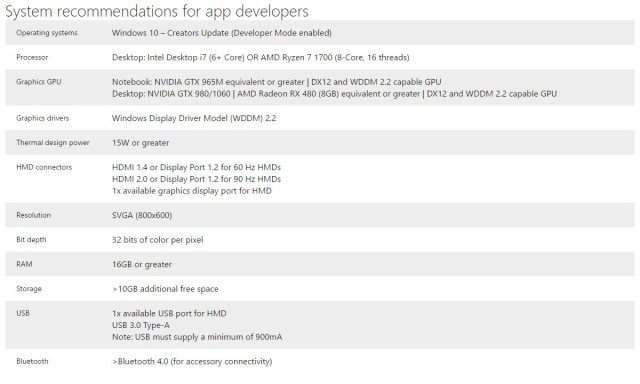 Minimum PC Specs for Consumers
Minimum PC Specs for Consumers
Design & Comfort
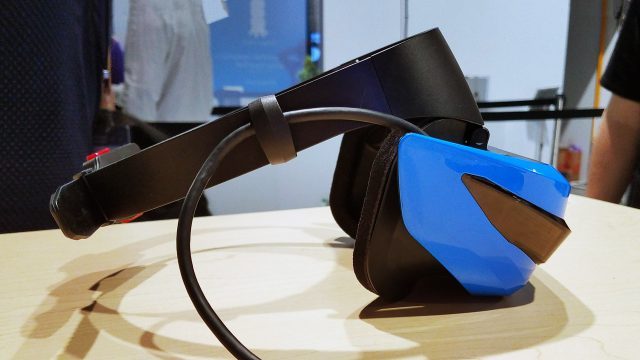
The Acer headset is incredibly light at 350 grams, or just over 3/4 of a pound; since I’m used to bigger PC headsets like the Rift and Vive, it gave me an odd sensation to feel immersed in VR with such little weight on my head. The headset features a single rigid ‘Halo style’ head strap that the display hangs off of in the front. One of the coolest features of this headset is its ability to flip up out of the way of your eyes at the point where it connects to the head strap. If you turn the display all the way up away from your face it clicks into place at forehead level, giving you the ability to check in with the real world. This allows you to easily take extended breaks from VR while working at your desk or during a gaming session when you might want to quickly grab a drink or a snack.
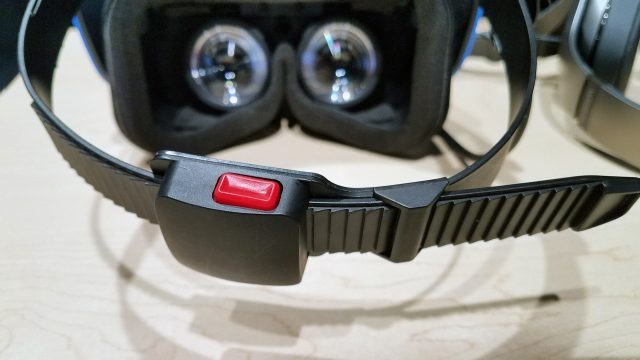 I only wore the headset for around 5 to 10 mins at a time across a few different demos at the Build conference so it’s tough to say what the long-term comfort might be like. However, the padding on the front of the headset strap seemed comfortable enough and didn’t bother me during my time with the headset on. There was one demo where the head strap started to make the back of my head a bit sore but this might have been caused by me tightening down the strap too much or seating it too low on the back of my head. Tightening and releasing the strap was a little unintuitive for me at first but I quickly got use to it and found it easy enough by my second or third demo. It operates essentially like a snowboard binding coupled with a buckle that feeds the strap in and out of a locking mechanism.
I only wore the headset for around 5 to 10 mins at a time across a few different demos at the Build conference so it’s tough to say what the long-term comfort might be like. However, the padding on the front of the headset strap seemed comfortable enough and didn’t bother me during my time with the headset on. There was one demo where the head strap started to make the back of my head a bit sore but this might have been caused by me tightening down the strap too much or seating it too low on the back of my head. Tightening and releasing the strap was a little unintuitive for me at first but I quickly got use to it and found it easy enough by my second or third demo. It operates essentially like a snowboard binding coupled with a buckle that feeds the strap in and out of a locking mechanism.

I appreciate Acer going with a bright colorful design. Looking around my office at the moment almost every electronic device in here is black. My keyboard, mouse, monitor, speakers, Rift, Vive, printer, PC tower. Adding some color to my environment is a plus for this headset in my opinion. At the moment it looks like the dev kits are only available for pre-order in blue, but Acer has also shown images of the headset in a bright red version in the past. I wonder if they ended up pulling the red version due to people having flashbacks to the look of the old View-Master, or if you we’re really lucky, Virtual Boy.
The bright blue color, light weight, and cheap plastic feel of some of the headset’s materials all make the Acer feel a bit like a toy. But for $300 I’m willing to live with some loss in materials quality. I don’t feel great about making any sweeping judgements on the Acer’s comfort given I didn’t spend any extended periods in the headset. It could be that over longer periods their cheaper strap design could cause comfort issues. However for the few times I had the headset on I was able to find a good comfortable fit.
Visual & Audio Quality
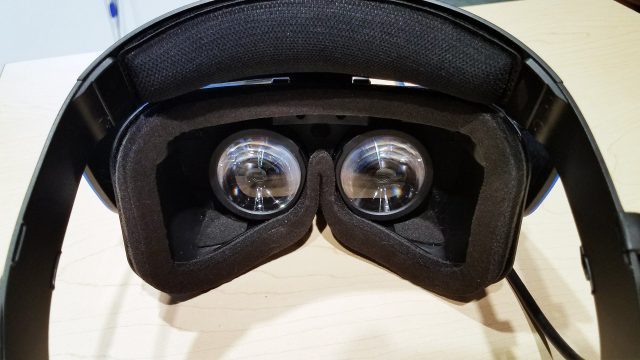 The Acer VR headset packs a 1440 x 1440 LCD display per-eye, with a refresh rate of 90Hz. I didn’t notice any screen door effect and text looked very legible. The downside of the Acer’s visuals are its field of view and lens quality. It uses fresnel lenses, and according to its official specs it has a 95 degrees horizontal field of view.
The Acer VR headset packs a 1440 x 1440 LCD display per-eye, with a refresh rate of 90Hz. I didn’t notice any screen door effect and text looked very legible. The downside of the Acer’s visuals are its field of view and lens quality. It uses fresnel lenses, and according to its official specs it has a 95 degrees horizontal field of view.
The Acer’s lenses just can’t compare with the more expensive headsets. They seemed to suffer from a bit more distortion around the edges, although if the headset is worn precisely in your ‘sweet spot’ you might not notice this. We don’t have direct measurements for comparison yet, but it felt to me like the Acer had a bit narrower FoV than either the Rift or the Vive. Some of that may have been due to the lower quality lenses. Additionally I did have one friend at the conference complain that the LCD display in the Acer felt worse to him than the OLED displays in the Rift and Vive. I’ll need more time in the headset to get a good feel for the quality of each.
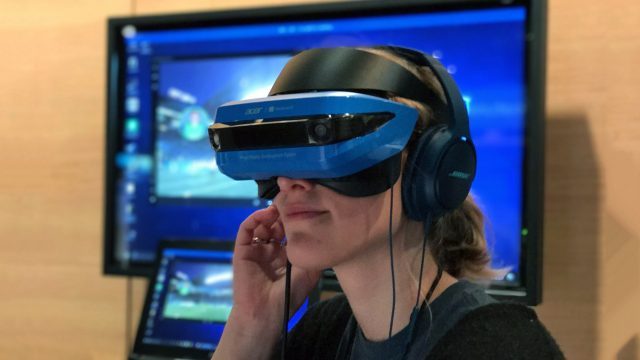
As far as audio goes there were two big things I noticed. No built-in mic and no built-in headphones. None of the demos I tried involved voice communication, but if they had I would have needed a mic attached to a pair of headphones since the Acer audio jack handles both the audio and microphone support. Not having built-in headphones or a mic is a bummer as someone who spends a lot of time in social VR settings, but it’s an understandable move here; allow users to provide their own headphones and mic and keep the price down as much as possible.
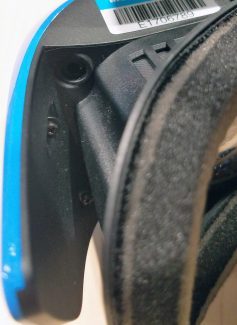
One of the exhibitors was nice enough to let me futz around with the audio port, plugging and unplugging their set of headphones. I wanted to test this because the port seems somewhat inconveniently located above the left eye in between the faceplate and the Acer’s exterior blue shield. If you have large hands you might find some difficulty plugging in your pair of headphones in this cramped space as I did.
Overall I found the visual and audio experience of the Acer headset to be a little lower quality than the other major desktop VR systems. The resolution looked great, the field of view was a bit lower than that of the Rift or Vive, and the lenses were certainly of poorer quality than the higher end headsets. But for $300, delivering a VR experience that really isn’t that much worse than a higher end headset is really impressive.

